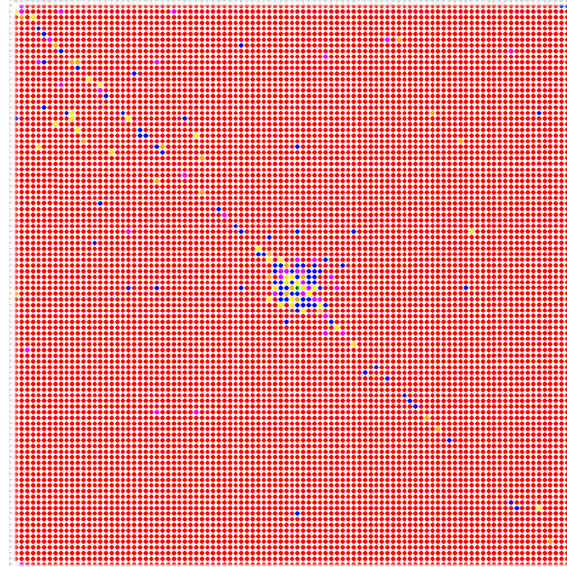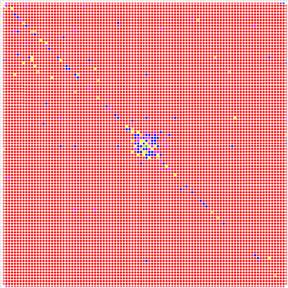 |
Findings of the EMU Project
Patterns of Habitation - Memorable
Addresses and EMU's Appearance from Above.
When the EMU WEBGRID first went online in 1997, word about the facility grew by "word of mouth". As people were emailed in group fashion and invited thus to join the EMU community, they told other people about it, and over time the number of places within the grid grew. Many tended to be from interested parties in a range of countries, including the UK, the USA and Russia.
Users of the EMU web grid project tended to form along an discernable 'line' which corresponded to those numbers most easily remembered. For example numbers which involved identical numerals e.g. 22, 33, 44, etc were often the most favoured 'addresses', and often users would choose grid 'addresses' which were combinations of paired numbers; for example 22:44 as a grid co-ordinate.
Observations were made about the number of people arriving at EMU over a given time. Access to the server containing logs of who arrived and who moved and so on was not easily obtained, due to the very institutionalised nature of the organization hosting the EMUWEBGRID ‘city’. A single ‘snapshot’ was taken of the grid in 2001 and this was used as the basis for most analysis.
As a result, the occupied dots on the grid, if seen from a 'zoomed-out' view form a line like pattern, from the top left of the grid to the bottom right. In many ways this pattern resembles the way in which real space in physical cities becomes occupied - a kind of semi-random sprinkling of occupied spaces where a pattern reflects a common human desire - in this case to be able to remember where one's site is for future reference. (see Fig 1. Below)
 |
Fig 1. (diagram of EMU seen from above)
Recommendations of EMU Participants
The overall response to EMU was enthusiastic among those who took part in the project. Participants contributed ideas to improve the site, among them:
![]()
The implementation of a facility to enable people on the grid who are present simultaneously to communicate, such as via text 'chat'.
Chat clients like AOL instant messenger, and ICQ enable people to share real-time synchronous text exchange. "Chatting" via text conversation, particularly for those who were 'at home' on EMU (i.e. attending to their own sites, or surfing those of other EMU citizens) was something that participants expressed a desire for. Implementing this may be as simple as having the EMUwebgrid become the 'framework' around which a specific AOL messenger system was made available. Hosting an EMU chat area via an existing chat client would be easier than implementing one from scratch. Chat and email could be made available to EMU KIOSK users via on-screen touch keyboards which appear on the screen and which can be used by touching the screen and 'typing' the keys that appear there. Alternatively, physical keyboards could be built into the design of EMU KIOSKS.
Other 'city' metaphor based online communities such as Activeworlds.com, and Alphworld.com provide a 3D environment which participants can 'occupy' in the form of 3D graphical 'avatars'.
8.
47:47 is a boring spot. Surely we dots can communicate with each other? Something!
Yeah, I know, shut up...
![]()
The ability to upload graphics to greater personalise the dot 'home' positions.
At the MIT Media Lab in 1998 while I was there on a research visit it was suggested by a colleague, John Madea, that the side be made more fluid in terms of navigation. The fact that you have to wait for the site to upload when you want to 'move' around the grid using the direction buttons detracts from the experience of the site.
![]()
Patterns of Habitation of Other Online Cities
As outlined in the book "Mapping Cyberspace" (Kitchin, R, and Dodge, M, 2001) In the 3D web city project known as "Alpha World" and users often exploited the ability to construct 'buildings' in pattern formations to enable 'graffiti' to be written viewable only from a high position above the city.
The relationship between the organisation of shared online urban space and the ways in which inhabitants seek ways to personalise that space resembles in many ways how people in real cities seek to personalise their own environment.
![]()
Digital Graffitti and Making a Mark: Personalization of Shared Online Space
Where anonymity is imposed by the structure and social relations of urban environments, signs which indicate the passage of people through space proliferate. This is particularly noticeable in very large cities, where the unofficial scrawlings, markings and notices made by inhabitants on walls public phone booths and other surfaces reflect the desire to have 'left one's mark'.
In more organised graffiti forms, such as the spray paint art of the 'hip-hop' movement this engagement with the city as a social platform for artistic expression reaches its zenith. It is important that designers of online shared spaces build into those spaces the opportunity for inhabitants to personalise their environments. This was a consistent request among the users of the EMU web grid environment, and the more successful web spaces which employ a spatial urban metaphor have the opportunity for inhabitants to make their own mark on the overall 'look and feel' of the city.
Restrictions on budget and resources meant that most of these suggestions were not implemented, however the EMU site is intended to be an ongoing part of the Australian Centre for the Moving Image, and there is every chance that such modifications will be implemented with time.
 |
Fig2. Zoomed-out view of the EMU WEB GRID as seen from above: kind of semi-random sprinkling of occupied spaces where a pattern reflects a common human desire - in this case to be able to remember where one's site is for future reference.
Due to the limited nature of access to the server, it has proven difficult to
obtain much of an overview of the nature of population changes since the ‘snapshot’
was taken in 2001 (link below). The institution (Cinemedia) was devolved into
the Australian Centre for the Moving Image (ACMI) and in the process the author
of the java-scripted city as well as its system operator (responsible for maintaining
EMU and monitoring progress) ceased to work for the new organization.
What are the ‘outposts’ of the EMUWEBGRID? The grid is a 100 by 100 dot square. That means there are 1000 dots within the current city. This could be made infinitely expandable by simply recycling the EMUWEBGRID system and having new ‘versions’ extend in each direction, effectively becoming the regions beyond those of the original grid. When you reached the limits of one city, you would start another, like a large tile adjoining the other tiles, each ‘tile’ being an EMUWEBGRID.
To aide online discussion in EMUWEBGRID, the use of a group discussion list involving dynamic threads could be implemented alongside the existing facility. The grid could be hooked up to a ‘groups’ site such as yahoo groups, or similar off-the-shelf interest group/list generating site and thus be the portal for online conversation about the site. Integration of such a list within the EMUWEBGRID site itself that would be even more of an improvement. The idea of a chat facility was flagged by many people, so that when inhabitants were online at the same time in the grid, they could chat among themselves.
In summary, users felt quite open about recommending uses for the grid, and although coming at it ‘cold’ i.e. with no real introduction, seem to have shared knowledge about it via electronic ‘word of mouth’. This was a genuinely global citizenry, one which was well aware of the diffuse nature of its own makeup – those who took pains to claim two dots for example, one private and one public echoed the sentiments of those who see facilities as EMUWEBGRID, indeed the web as a whole as a combination of both.
Users were not shy about expressing themselves about the idea of EMUWEBGRID,
and many were curious as to what it was, and how they could use it. There was
genuine interest in building a community, which with time might have led to
something of a critical mass of people who more or less made it their own. The
user who made reference to the nautical metaphor showed great spirit about what
the site was trying to do. There was much humour as well for example: ‘can’t
get a bagle, welcome to the neighborhood’. On the whole the inhabitants
were curious and a bit perplexed by their status as ‘inhabitants’.
Proposal for an improved EMU WEBGRID
A "Frozen Moment" portrait of EMU WEBGRID, with comments left by participants as of October 2000.
Observations about the "Frozen Moment" of the EMU WEBGRID